Friday, November 9, 2007
Wednesday, May 23, 2007
Wednesday, February 7, 2007
Units of Mesure (Recap.)
This is sort of a recap on my other post called, Units of Measure.
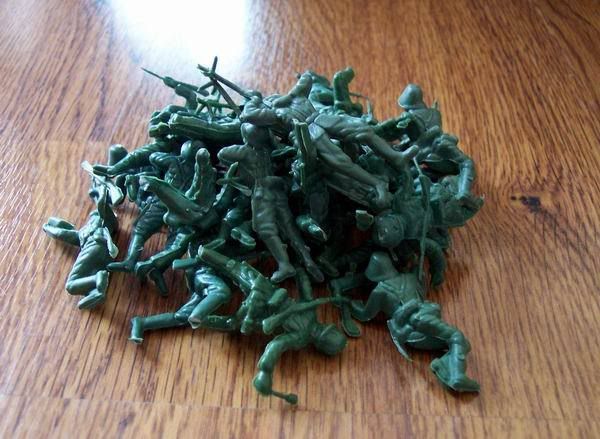 This is a single platoon sized unit in a pile.
This is a single platoon sized unit in a pile.

There are two platoons in this pile.
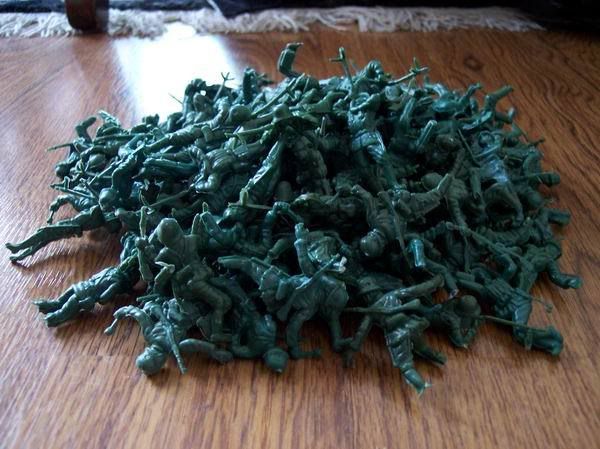
There is one TROOP in this pile. (4-6 platoons... this is about 140 soldiers so I threw in 4 more to make it gross.)
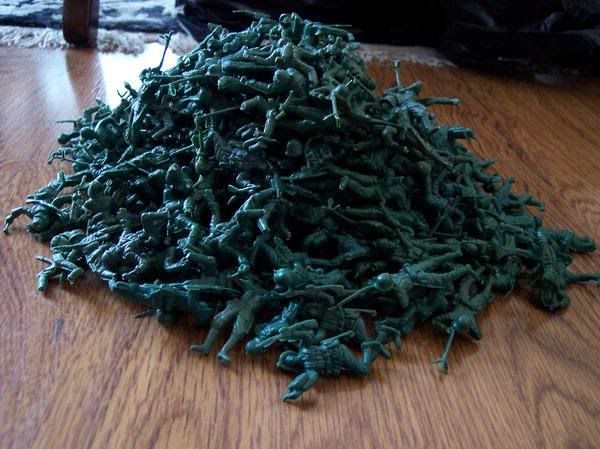
There are two TROOPS in this pile (about 300 soldiers.)

This is a squadron sized pile. (4-6 troops = 1000 soldiers.)
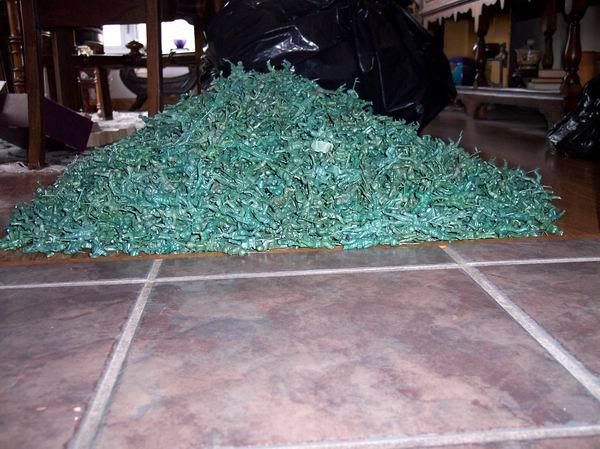

Both of these photos are what a small regiment looks like all piled up. (There are about 3000 to 5000 soldiers in a cavalry regiment.)
This gives you an idea of the scale of what I am working with and how many of the soldiers I am working with when I deploy them into their piles.
 This is a single platoon sized unit in a pile.
This is a single platoon sized unit in a pile.
There are two platoons in this pile.

There is one TROOP in this pile. (4-6 platoons... this is about 140 soldiers so I threw in 4 more to make it gross.)

There are two TROOPS in this pile (about 300 soldiers.)

This is a squadron sized pile. (4-6 troops = 1000 soldiers.)


Both of these photos are what a small regiment looks like all piled up. (There are about 3000 to 5000 soldiers in a cavalry regiment.)
This gives you an idea of the scale of what I am working with and how many of the soldiers I am working with when I deploy them into their piles.
Units of Measure
The word troop in the cavalry is a unit of measure...
This is sort of how it looks in the unit breakdown.

This is one soldier. A single unit, not troop.

This is a small section... maybe a detachment of a rank of unit measure. This could be the units that operate two M1 Abrams tanks. (Two drivers, and two gunners... )

This is a series of sections called ranks that form a unit called a platoon. The soldier that centers himself on the front of the platoon unit is called the platoon sergeant and the rear is platoon lieutenant.
 I had to make more room in this photo because a troop is a large unit of measure that usually has 100 soldier or more, or 4 to 6 platoons. The soldier out front is first sergeant and rear is the Captain. The first sergeant to call attention or address the troop will then yell out the word troop because it is a troop sized element. My troop was Comanche Troop which meant that it was third in alphabetical order on a squadron sized unit. (Which is about 4-6 troops/or 1000 soldiers.)
I had to make more room in this photo because a troop is a large unit of measure that usually has 100 soldier or more, or 4 to 6 platoons. The soldier out front is first sergeant and rear is the Captain. The first sergeant to call attention or address the troop will then yell out the word troop because it is a troop sized element. My troop was Comanche Troop which meant that it was third in alphabetical order on a squadron sized unit. (Which is about 4-6 troops/or 1000 soldiers.)
I think that this type of example has been done before, but there is still snow on the ground so I have just been prepping my soldiers for their next wave of attacks. I would install them out in the snow, but I am not wanting the Winter Soldier referrence.
This is sort of how it looks in the unit breakdown.

This is one soldier. A single unit, not troop.

This is a small section... maybe a detachment of a rank of unit measure. This could be the units that operate two M1 Abrams tanks. (Two drivers, and two gunners... )

This is a series of sections called ranks that form a unit called a platoon. The soldier that centers himself on the front of the platoon unit is called the platoon sergeant and the rear is platoon lieutenant.
 I had to make more room in this photo because a troop is a large unit of measure that usually has 100 soldier or more, or 4 to 6 platoons. The soldier out front is first sergeant and rear is the Captain. The first sergeant to call attention or address the troop will then yell out the word troop because it is a troop sized element. My troop was Comanche Troop which meant that it was third in alphabetical order on a squadron sized unit. (Which is about 4-6 troops/or 1000 soldiers.)
I had to make more room in this photo because a troop is a large unit of measure that usually has 100 soldier or more, or 4 to 6 platoons. The soldier out front is first sergeant and rear is the Captain. The first sergeant to call attention or address the troop will then yell out the word troop because it is a troop sized element. My troop was Comanche Troop which meant that it was third in alphabetical order on a squadron sized unit. (Which is about 4-6 troops/or 1000 soldiers.)I think that this type of example has been done before, but there is still snow on the ground so I have just been prepping my soldiers for their next wave of attacks. I would install them out in the snow, but I am not wanting the Winter Soldier referrence.
Friday, January 19, 2007
Plastic Morality
Q:So where does the Deployer draw a line and decide how many plastic toy soldier bodies are enough?
 A:For some reason one body never seems to make much of an impact. One can sometimes be enough, but then nobody really sees one body anyway. So the scale can make a great significance for observers to take notice. A few hundred in a pile will receive some attention because in these piles they are more noticeable and intimate due to scale. A few thousand and the piles began to look overwhelming but nothing is ever personal or on that personal level where a person can relate or associate one's own relationship to the pile or individual toy soldier unless one interacts or responds to the deployment.
A:For some reason one body never seems to make much of an impact. One can sometimes be enough, but then nobody really sees one body anyway. So the scale can make a great significance for observers to take notice. A few hundred in a pile will receive some attention because in these piles they are more noticeable and intimate due to scale. A few thousand and the piles began to look overwhelming but nothing is ever personal or on that personal level where a person can relate or associate one's own relationship to the pile or individual toy soldier unless one interacts or responds to the deployment.
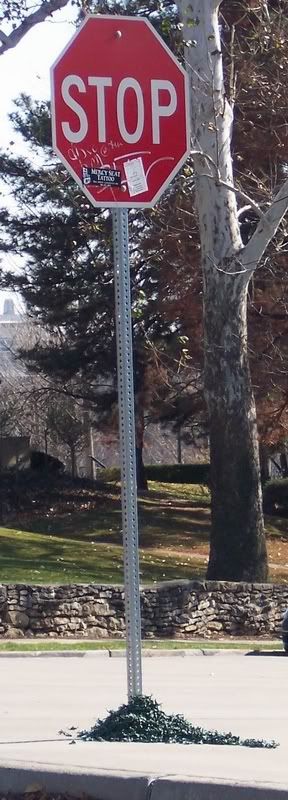 The piles and their relation to other objects become unique dialogs between the plastic toy soldiers and their new unexplored culture. In some instances it is obvious that the plastic toy soldiers are being kicked around, which is expected. However, the piles that stay up and not shift or change position almost baffle me. It's as if they are placed in a spot that is either difficult to get to, or they are on the path that nobody bothers traveling because it is littered with too many obstacles.
The piles and their relation to other objects become unique dialogs between the plastic toy soldiers and their new unexplored culture. In some instances it is obvious that the plastic toy soldiers are being kicked around, which is expected. However, the piles that stay up and not shift or change position almost baffle me. It's as if they are placed in a spot that is either difficult to get to, or they are on the path that nobody bothers traveling because it is littered with too many obstacles.
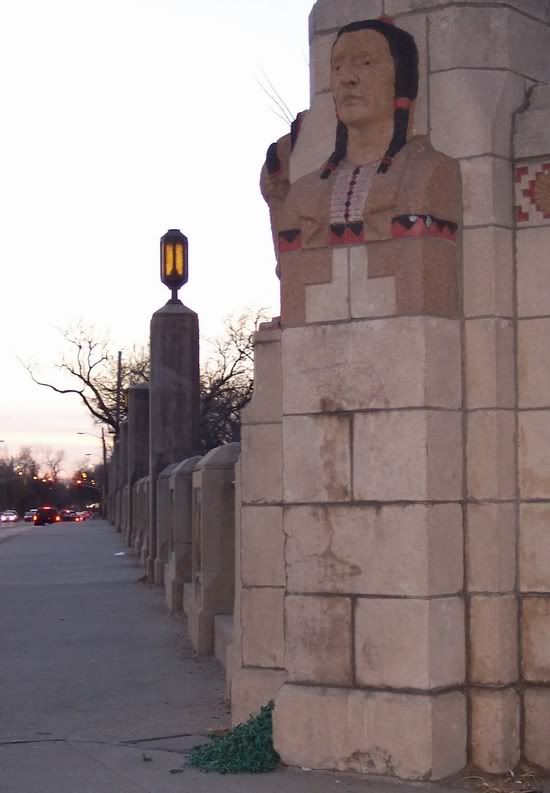 What makes the drop zones more exciting is the interaction between people of different age groups and people from cultures outside of the United States. The read of the work becomes more about where the drop zone is and what the pile's relationship to the space is.
What makes the drop zones more exciting is the interaction between people of different age groups and people from cultures outside of the United States. The read of the work becomes more about where the drop zone is and what the pile's relationship to the space is.
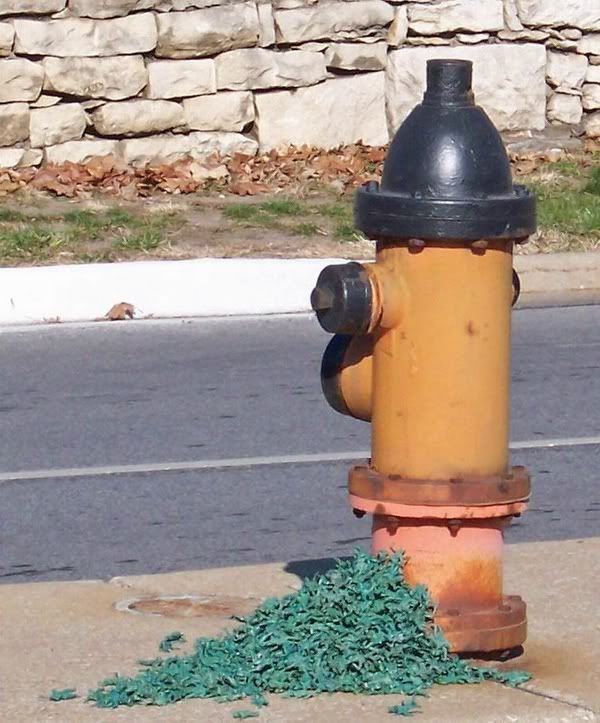 This drop zone seemed to last forever in Kansas City over by the Nelson Atkins Museum. I would not be surprised if the pile was still in the same place but it has been a few months since the this spot was installed.
This drop zone seemed to last forever in Kansas City over by the Nelson Atkins Museum. I would not be surprised if the pile was still in the same place but it has been a few months since the this spot was installed.
 A:For some reason one body never seems to make much of an impact. One can sometimes be enough, but then nobody really sees one body anyway. So the scale can make a great significance for observers to take notice. A few hundred in a pile will receive some attention because in these piles they are more noticeable and intimate due to scale. A few thousand and the piles began to look overwhelming but nothing is ever personal or on that personal level where a person can relate or associate one's own relationship to the pile or individual toy soldier unless one interacts or responds to the deployment.
A:For some reason one body never seems to make much of an impact. One can sometimes be enough, but then nobody really sees one body anyway. So the scale can make a great significance for observers to take notice. A few hundred in a pile will receive some attention because in these piles they are more noticeable and intimate due to scale. A few thousand and the piles began to look overwhelming but nothing is ever personal or on that personal level where a person can relate or associate one's own relationship to the pile or individual toy soldier unless one interacts or responds to the deployment. The piles and their relation to other objects become unique dialogs between the plastic toy soldiers and their new unexplored culture. In some instances it is obvious that the plastic toy soldiers are being kicked around, which is expected. However, the piles that stay up and not shift or change position almost baffle me. It's as if they are placed in a spot that is either difficult to get to, or they are on the path that nobody bothers traveling because it is littered with too many obstacles.
The piles and their relation to other objects become unique dialogs between the plastic toy soldiers and their new unexplored culture. In some instances it is obvious that the plastic toy soldiers are being kicked around, which is expected. However, the piles that stay up and not shift or change position almost baffle me. It's as if they are placed in a spot that is either difficult to get to, or they are on the path that nobody bothers traveling because it is littered with too many obstacles. What makes the drop zones more exciting is the interaction between people of different age groups and people from cultures outside of the United States. The read of the work becomes more about where the drop zone is and what the pile's relationship to the space is.
What makes the drop zones more exciting is the interaction between people of different age groups and people from cultures outside of the United States. The read of the work becomes more about where the drop zone is and what the pile's relationship to the space is. This drop zone seemed to last forever in Kansas City over by the Nelson Atkins Museum. I would not be surprised if the pile was still in the same place but it has been a few months since the this spot was installed.
This drop zone seemed to last forever in Kansas City over by the Nelson Atkins Museum. I would not be surprised if the pile was still in the same place but it has been a few months since the this spot was installed.
...And in the Streets.

I found it interesting that some places where the drop zones were implemented, that they were either ignored or run over in a matter of minutes. This particular pile was run over twice in three minutes. One of the cars rolling over the toy soldiers had a yellow ribbon on the trunk of the car.

It's a hell of a thing to be run over by a car. I mean you are here one minute and then crunch. Most of my surrogates are expendable and once they are deployed they are expected to fend for themselves. If its not the roadside bums, it being run down by blind idiots with yellow warning ribbons, or professional green-horn truck drivers.
The street proved to be a bad place for deployment. The drop zones are compromised by the complacent masses, and the deployment must move quick as to not become collateral damage and run down in the middle of road.
Roadside Bums
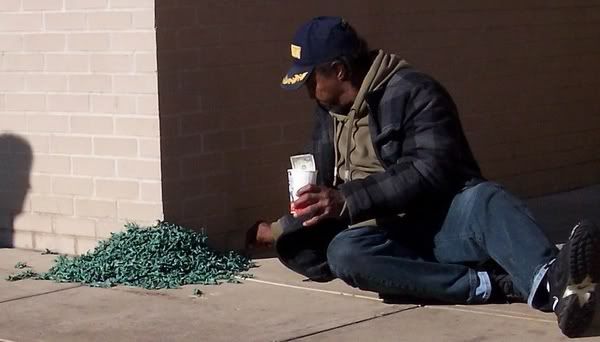 While I was on patrol for places that would make a good drop zone, I found this one spot... which was in a place called The Plaza in Kansas City Missouri. When out of nowhere I was ambushed by a roadside bum. It happened so fast that I did not have time to think, and in a blink of an eye, there were things that were happening that I needed to shoot with my camera. This faux homeless man instantly started drilling me questions as if he was the chief of Homeland Security. I refused to give in to his badgering and gave him the run around so that I could put some distance between me, the deployed soldiers, and the interrogator.
While I was on patrol for places that would make a good drop zone, I found this one spot... which was in a place called The Plaza in Kansas City Missouri. When out of nowhere I was ambushed by a roadside bum. It happened so fast that I did not have time to think, and in a blink of an eye, there were things that were happening that I needed to shoot with my camera. This faux homeless man instantly started drilling me questions as if he was the chief of Homeland Security. I refused to give in to his badgering and gave him the run around so that I could put some distance between me, the deployed soldiers, and the interrogator.At one point I was expecting him to tell me that he was a Vietnam vet, or that his car broke down and he needed gas. I had heard most of these lines before from up the street where his competition feverishly work the corners.
After he felt secure enough for the soldiers to occupy the same space he was pulling contributions from, he decided to take a break from his hard day of pan handling to run his hands though the pile of bodies. His hands were very clean for a homeless man, and so I thought it would not soil the soldiers, and this made a great photo opportunity.
The man was more interested in posing for the camera and begging me to bring him a bag of toys for his unfortunate children at his house for Christmas.
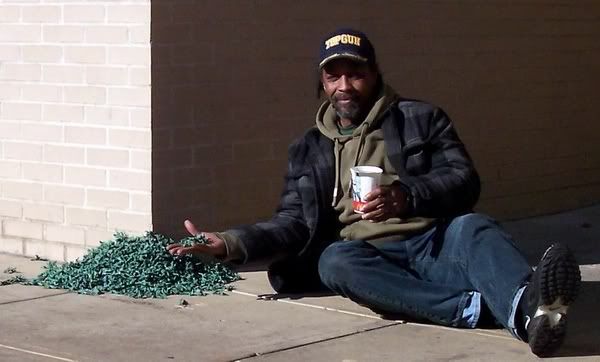
Art moves people. It moved this man about ten feet from his five gallon bucket he was using as a seat.
Subscribe to:
Posts (Atom)